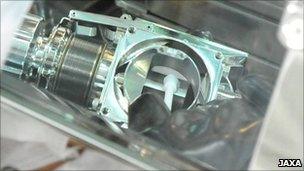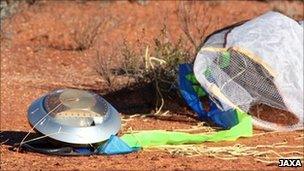Japan probe collected particles from Itokawa asteroid
- Published

A gloved hand wipes the inside of the capsule with a clean spatula
Japanese scientists have confirmed that particles found inside the Hayabusa probe after its seven-year space trip are from the asteroid Itokawa.
A statement from the country's space agency said microscopic analysis of 1,500 grains retrieved from the craft's sample canister proved they were of extraterrestrial origin.
The announcement represents a huge triumph for Japan.
It is the first time samples from an asteroid have been returned to Earth.
"It's a world first and a remarkable accomplishment that [Hayabusa] brought home material from a celestial body other than the Moon," Japan's science and technology minister, Yoshiaki Takagi, told a news conference in Tokyo.
Junichiro Kawaguchi, the project manager on the mission, told reporters: "I don't know how to describe what has been beyond our dreams, but I'm overwhelmed by emotion."

The sample capsule fell back to Earth in the Woomera Prohibited Area of Australia
The Hayabusa mission spent three weeks orbiting asteroid Itokawa in 2005 and attempted to pluck dust from its surface.
The $200m (£125m) mission encountered many technical problems, from being hit by a solar flare to experiencing propulsion glitches.
No-one was quite sure whether it had succeeded at the time because the capture mechanism appeared to fail just as the craft approached the asteroid's surface to make the acquisition.
But each time an issue came up, the Japanese project team found an elegant solution to keep Hayabusa alive and bring it back to Earth - albeit three years late.
The sample capsule was delivered safely to Earth over Australia in June.
The main Hayabusa spacecraft, however, was destroyed on re-entry to the atmosphere.
Scientists at the Japanese space agency's (Jaxa) Sagamihara Campus in Kanagawa then spent the next five months subjecting minuscule grains found inside the canister to detailed examination.
"Almost all of them are extraterrestrial and come from Itokawa," Jaxa announced in its statement.
It would appear that Hayabusa must have disturbed the surface of the asteroid sufficiently in its approach to kick up dust into the probe's capture tool, even if the mechanism itself did not work as designed.

The surface of a spatula is viewed under an electron microscope
Professor Trevor Ireland is an Australian scientist working on the mission and was involved in the preliminary examination.
"The identification of extraterrestrial particles in the Hayabusa sample capsule is an astounding achievement," he said.
"While the particles are small, no more than the width of a human hair, they hold the tell-tale signature of extraterrestrial material."
The particles contain the minerals olivine, pyroxene and plagioclase.
Although common on Earth, these particles are said to be quite different in the Hayabusa samples, in their relative abundances and in their atomic composition.
The analysis fits with what Hayabusa saw with its remote-sensing instruments at Itokawa. These minerals are also common in certain meteorites, as is the mineral troilite (an iron sulphide) which has also been identified.
"This latter mineral is not found on the surface of the Earth," said Professor Ireland, who is affiliated to the Australian National University in Canberra.
"As such, everything points to a successful sample return from Itokawa."
The Hayabusa particles represent only the fourth set of extraterrestrial materials brought to our planet by spacecraft.
Those other materials include the Moon rocks recovered by US and Soviet missions; cometary dust captured by the American Stardust probe; and particles in the "solar wind" returned by the Genesis spacecraft, also operated by the US.
- Published6 July 2010
- Published13 June 2010